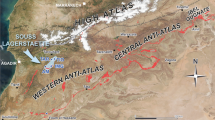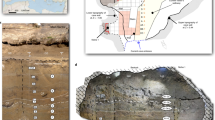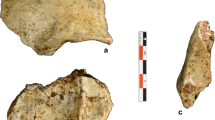Abstract
I HOPE I may be allowed to call myself an archæologist, although a very humble one, yet I find myself in complete disagreement with my friend Mr. Reid Moir in NATURE of December 30, p. 1006. After C. J. Thomsen1 had in 1836 revived the idea of Lucretius2 and divided the past history of man into the three ages of stone, bronze and iron, there was one stone age, but when the discoveries of Boucher de Perthes had been recognised by English savants, Sir John Evans3 in 1859 pointed out that this age must be divided into two, that in which the fauna was extinct and that in which it was recent. Later on, Sir John Lubbock4 suggested that these two periods should be termed respectively the palæolithic and neolithic ages. It was soon noted, however, that these ages did not pass into one another, but that between them there was a great gulf fixed, and this became known as the great hiatus.
This is a preview of subscription content, access via your institution
Access options
Subscribe to this journal
Receive 51 print issues and online access
$199.00 per year
only $3.90 per issue
Buy this article
- Purchase on Springer Link
- Instant access to full article PDF
Prices may be subject to local taxes which are calculated during checkout
Similar content being viewed by others
References
Thomson, C. J., "Ledetraad til Nordisk Old Kyndighed" (Copenhagen, 1836).
Lucretius, "De Rerum Nature", 5, 1282–96.
Evans, J., in Arch"logia, 38, 293. cf. Phil. Trans., 311 ; 1860.
Lubbock, J., "On the evidence of the Antiquity of Man afforded by the Physical Structure of the Somme Valley", Nat. Hist. Rev., 144–169 ; 1862. Prehistoric Times (London, 1865).
"Untersögelser i geologisk-antiquarisk Retiring af" G. Forch-hammer, J. Steenstrup, og J. Worsae cf. also Mem. Soc. Vaudois. 6 1860.
Lubbock, J., "Prehistoric Times" (London, 1865) p. 196.
Piette, E. L' Anthropologie, 5, 129–146 ; 6, 276–292 ; 7, 1–17, 309, 385–427 ; 14, 641–653 ; 16, 1–11,
Piette, E., "Hiatus etlacune, vestiges de la pénode de transitions la grotte du Mas d'Azil." Bull. Soc. d'anthrop. Paris, Ser. iv. 6, 235. cf. also L'Anthropologie, 6, 276.
Brown, John Allen, "On the continuity of the Palæolithic arid Neolithic Periods", J Anthrop. Inst., 22, 66–98 ; 1893.
Vielle, E., "Points de fiéches typiques de Fère-en-Tardenois", Bull. Soc. d'anthrop. Paris, Ser. iv, 1, 959 ; 1890.
Sarauw, G. F. L., "En Stenalders Boplads i Maglemose ved Mallerup", Aarbøger for nordisk Oldkyndighad og historie, Ser. ii, 18, 148 ; 1903.
Déchelette, J., "Manuel d'archeologie" (Paris, 1908), 1, ii, Ch. 1.
Sollas, W. J., "Ancient Hunters" (London., 1911 and 1924), Chv-Xiii.
Burkitt, M. C., "Prehistory" (Cambridge, 1921), Ch. xii.
Macalister, R. A. S., "A Text-book of European Archæology", Vol.1 (Cambridge, 1921), 516–7.
Childe V., Gordon, "Dawn of European Civilisation" (London, 1925), Ch. i.
Author information
Authors and Affiliations
Rights and permissions
About this article
Cite this article
PEAKE., H. The Term Mesolithic. Nature 133, 104–105 (1934). https://doi.org/10.1038/133104b0
Issue Date:
DOI: https://doi.org/10.1038/133104b0
Comments
By submitting a comment you agree to abide by our Terms and Community Guidelines. If you find something abusive or that does not comply with our terms or guidelines please flag it as inappropriate.



